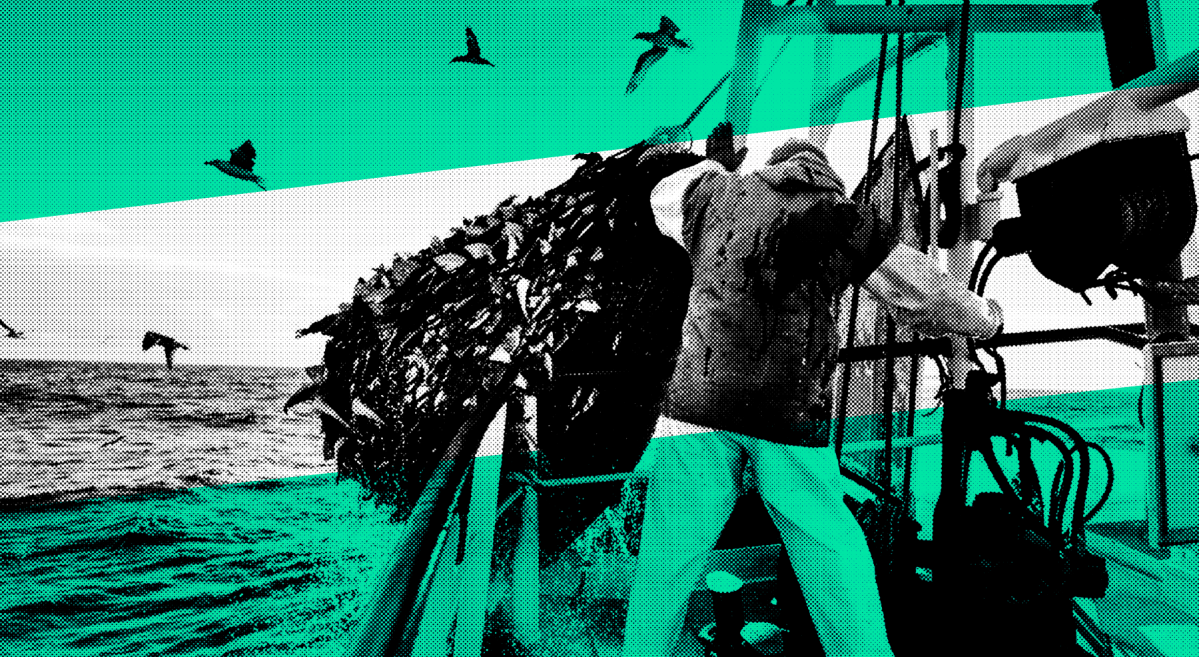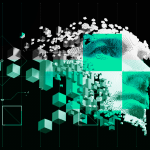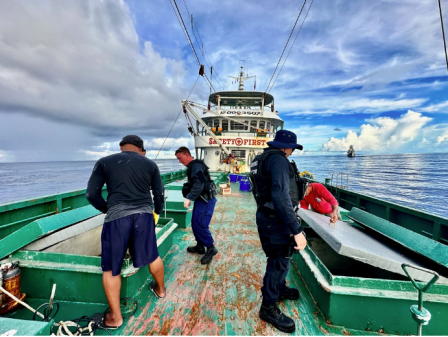As it helps combat unlawful fishing internationally, NGA is ‘posturing’ for an AI-driven future

As illegal, unreported and unregulated fishing (IUU) threatens food security, wildlife and socio-economic stability in different parts of the world, government and commercially generated data and analytics capabilities purchased and refined by the National Geospatial-Intelligence Agency are informing and enabling military efforts to combat the unlawful activities in waters near South America — and soon, maybe elsewhere.
“The analytics that we’re buying are being used to identify, monitor and track fishing vessels in real-time to identify bad actors, describe their patterns, and inform international engagements and patrol operations. We can create trends and share those with foreign mission partners,” Jared Newton, technical executive of NGA’s Source Commercial Operations Group, told DefenseScoop in a recent interview.
Considered an escalating global concern by many experts, IUU activity — and the potential collapse of certain fish stocks associated with it — is placing millions of people at risk of losing access to their primary food sources. The activities are often linked to organized crime and forced labor. And people who live in developing countries are the most vulnerable to being impacted by IUU harms.
“If you go read press articles, you’re regularly seeing those regional news media outlets talking about sustainability, and that threat to their country. These types of fishing operations are putting at risk their standard of life and living,” Michael Kurey, a program manager for enhanced domain awareness, recently explained.
NGA as an agency stations itself in places where its customers — like military commands — are housed. Kurey is based in Miami, Florida, near U.S. Southern Command’s headquarters. Several years ago, his team began incorporating some of those commercial data and analytics resources acquired via NGA’s Source Commercial Operations Group into an application called Enhanced Domain Awareness, or EDA.
In separate interviews, Newton and Kurey briefed DefenseScoop on how EDA is evolving and expanding to supply a growing list of government and military entities with a consolidated, near real-time strategic picture of IUU fishing activities in waters where they can be extremely difficult to trace.
‘The beauty’ of this technology
President Biden said IUU fishing undermines U.S. national security and is “among the greatest threats to ocean health,” in a policy memorandum released last year — through which he directed federal agencies to pursue a variety of actions to help spot and stop it.
“Long story short, IUU is a global problem. There are actors that fish illegally or skirt the line of legality globally,” Newton explained.
Sometimes, actions or trends in one region shed light on activities in others as well.
“I’ll come out and say it — yes — we’ve seen Chinese vessels indicating activity that is considered IUU. I will say, though, the challenge of IUU in general is that ‘illegal’ is paired with ‘unregulated,’ so there are things that are very clearly against law and in some things that kind of skirt the lines,” Newton said.
But “the beauty of commercial analytics and geointelligence,” in his view, is that they provide an “avenue to openly track and communicate when international rules are being skirted or broken.”
The data and associated, sophisticated services that NGA’s Source Commercial Operations Group buys for Defense Department use can be derived from automation and artificial intelligence. That’s “a very different approach than you’ll probably hear with some of the other defense organizations that focus exclusively almost on acquiring algorithms and ingesting them into government operations,” Newton said — though he also noted that NGA additionally does that “at an agency level.”
The vendor and subcontractor the commercial operations group purchases data and services from broadly apply AI and machine learning to monitor and surveil an area that’s approximately the size of around 34 million square kilometers.
“And they are integrating satellite imagery data, terrestrial AIS, which is transponder data that ships broadcast, company registry and ownership information, vessel spec databases, nautical charts — a variety of different sources — to characterize what individual entities are doing within that space. So the AI is able to identify the high-probability ‘bad actors’ by applying historic knowledge of what the entities in the space are doing over time,” Newton said.
Sometimes, vessels participating in IUU activities turn off their communication systems to essentially hide themselves from capabilities that are made to track them.
“That’s what we call a dark target,” Newton explained.
“They typically do that before they go and do something nasty. Where the AI kind of helps is because it’s pulling from a variety of different sources to include imagery. Those alerts can then tip an imaging sensor to then try and maintain custody of that vessel,” he said.
NGA, according to Newton, “obviously has to apply algorithms or eyeballs to every image pixel” that is brought into the agency’s secure assets.
“Just to give you a sense of the scale and how much we’re talking about — there’s around 470 U.S. own space-based remote sensing systems that are available today. And that’s going to expand to around 1,400 by 2030, we expect. So globally, there’s about a seven-fold increase in those systems. So the limiting factor isn’t how much of the Earth we can observe or how often — it’s how quickly we can derive insights from that data. And so that’s where, of course, AI and automation comes in. It helps us increase the speed and our capability to react to military and human humanitarian response efforts,” he explained.
With that in mind, NGA recently began scaling its Economic Indicator Monitoring contract, which is now essentially the agency’s model for buying commercial computer vision data. Newton confirmed that NGA recently increased the funding ceiling for that contract, with the explicit intent to “buy more commercial analytics.”
Although he couldn’t get into specifics, Newton also spotlighted a particular maturing project to help combat IUU that stems back to efforts being steered by U.S. Southern Command that relies on such industry-produced analytics.
The command is bringing the data, imagery and alerts NGA acquires commercially — and a range of other government and open-source datasets — into a curated IUU fishing reference database.
That information can further be pulled into the EDA platform to display a strategic picture of such activities and trends, organized reports, and to ultimately perform mission briefs and patrol operations led by Southcom and its international partners.
“We’re always looking at ways to provide more data, better and faster” as this work progresses, Newton noted. “So, we’re looking at doing a data integration and modernization study for illegal fishing with our partners in Southcom, so that we can get them data even faster than what we’re giving them.”
In an update via email this week, an NGA spokesperson told DefenseScoop that ”the modernization study for Southcom EDA will kick off early this summer and will run over several weeks.”
For the effort, the agency will be collaborating with the military command and vendors “to develop technical recommendations for improving timeliness,” the official said.
A ‘partner-enabling’ environment
The overarching concept for EDA was in some ways born out of nearly seven years of lessons Kurey learned while embedded with Southcom through its partnership with NGA.
“Those formulated around either command exercises or world events — particularly humanitarian assistance and disaster relief task forces — so things like earthquakes and hurricanes,” he explained.
There was an apparent need to better organize the complex, convoluted data and information through models or other means to then report to all echelons of government.
“So think tactical, operational, strategic — and the same piece of data can inform all three potentially different means behind it,” Kurey said.
The “wheels were moving” there, he added, before the COVID-19 pandemic surfaced. Then, a governmentwide need for secure but unclassified working environments — and EDA’s unique capabilities that allow partner nations to collaborate and share data-driven insights — accelerated the platform’s development.
Today, the program continues to evolve, informing national security operations beyond the realm of IUU fishing.
“When you log into EDA, whether it is on the U.S. side or the partner-nation side, many of the projects that you’ll see in there revolve around different priority lines of effort,” Kurey explained. For Southcom, besides IUU “you’ll find other things like counter-narcotics missions, and things like that. But it’s all encompassing, and you’ll find information and data and projects that I mentioned before will support a tactical environment, operational environment, or strategic messaging,” he said.
Still, within the “partner-enabling environment of EDA,” Kurey noted, IUU fishing activities are top of mind. Often, when he speaks to U.S. military allies and partners at international engagements, “the IUU fishing topic is usually the first thing brought up in the room — it’s the icebreaker,” he said.
To Kurey, projects like this with EDA have significance because they “drive those conversations with data versus speculation.”
The models that are running within the environment “fuse on-the-fly either dynamic or static data provided through relationships” NGA has with non-governmental organizations and its own organic and acquired information sources, he added. And “all of this gets fed into data-driven models that spit out and inform visualizations within EDA.”
It’s no secret that China’s distant water fishing fleets, sometimes associated with IUU practices, have been growing exponentially over the last decade.
“The numbers are unknown, in the sense that they range from 4,000 to 15,000-plus vessels. I mean, that’s a lot of noise. How do you refine and narrow the aperture of where you’re looking and what you’re looking at and why you’re looking at them to drive action?” Kurey said.
“The military talks about how intelligence drives operations. So, [EDA] is an example,” he noted.
As the platform continues to mature and blossom, now other combatant commands — including U.S. Northern Command, European Command and Indo-Pacific Command — are beginning to explore how they can integrate it into their own initiatives for data organization and support.
“We’re in the process of discussing with them what requirements they may have and guiding them on how to implement them,” Kurey confirmed.
Though there’s still a lot to be realized with the EDA platform, in his view it marks one major mechanism through which the government is “posturing for that AI future.”

This story was featured in DefenseScoop Special Report: Operational AI in the U.S. Military — A DefenseScoop Special Report




